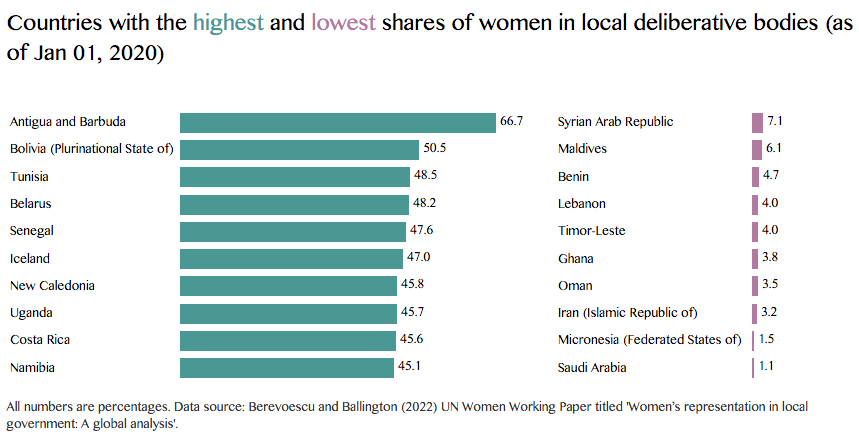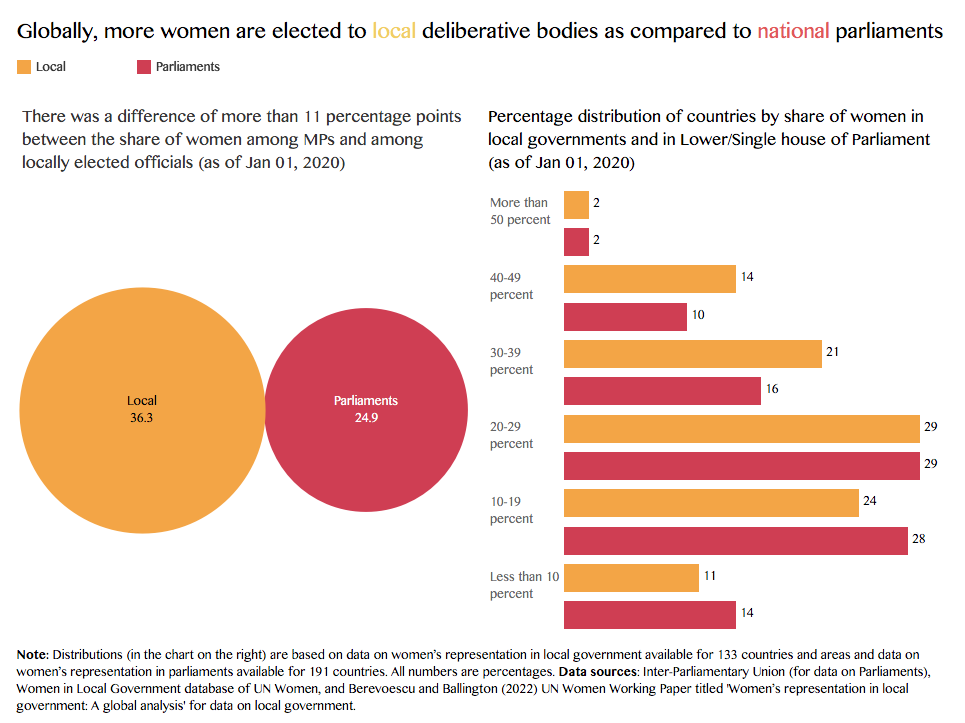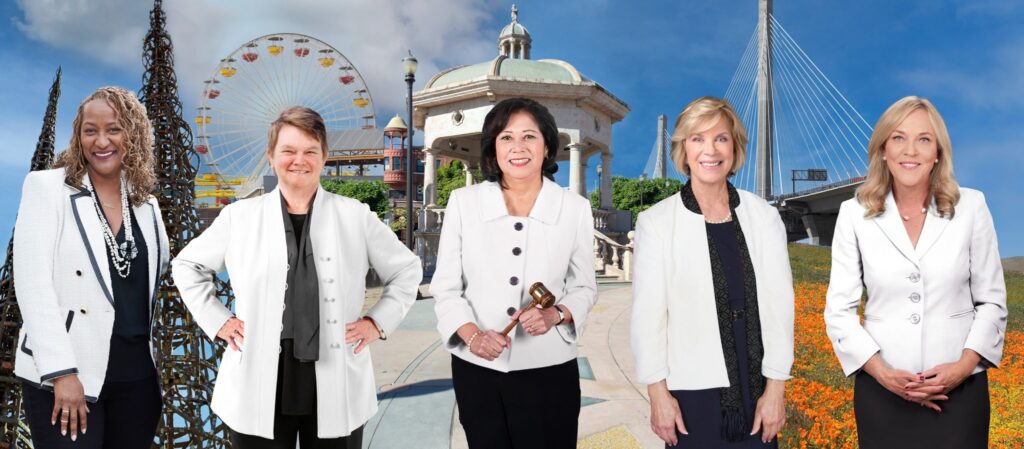As women elected officials move from local politics towards the subnational and national levels, they begin to be replaced by more and more men.

Women comprise just over one-third (36 percent) of the over 6 million elected members in deliberative bodies of local governments globally, according to a new working paper released by U.N. Women last month. Although far from parity, this is the best representation women seem to get across levels of government: As they move towards the subnational and national levels, they begin to be replaced by more and more men, data shows.

The U.N. Women paper is based on data available from 133 countries as of January 1, 2020. Antigua and Barbuda had the highest share of women at the local level—two in every three elected officials were women. It was followed by Bolivia with parity, Tunisia (48.5 percent women), Belarus (48.2 percent) and Senegal (47.6 percent).
While women made up at least 40 percent of elected legislators at the local level in 20 countries, in the majority of countries where data was available, women remained severely underrepresented, the report found. In 70 countries, the share of women remained between 10 and 30 percent, and 15 countries had less than 10 percent women’s representation.
Women’s Representation at the Local Level Is Considerably Better Than at the National Level
While parity is still a long way off at the local level, women’s representation at this level is considerably better than at the national (parliamentary) level by almost 11 percentage points on average.
While overall there is a correlation between the level of women’s representation in parliament and local government, there are many cases where these two diverge. Take India, for example, where only 14 percent women were elected to the lower house of Parliament in the 2019 election, but there were more than 44 percent women at the local level (as of 2017). Or Tunisia, where only 26 percent are women.

“Some of these disparities are explained by the use of quota (or the type of quota) at one level, but not the other level. The difference in global averages is also shaped by how the averages are calculated (by number of members in parliament and local government in each country),” said Ionica Berevoescu and Julie Ballington, authors of the report. The data for the local level is not as complete as that for parliaments, they added.
There is more to this difference than just methodology or electoral systems, though.
Local Social Norms and Power Dynamics Lead To Variations in Representation Within Countries
Rachel Brulé, assistant professor of global development policy at Boston University, explains the impact of gender stereotypes in shaping women’s success at different levels of politics. Citing U.S.-based research by Anzia and Bernhard (2022) that finds women have greater advantages over men in “stereotype congruent” contexts—that is, women are more likely to be successful in contests that reinforce gender stereotypes—Brulé explained: “Women have greater advantages in city council than mayoral races, still greater advantages in school board races, and decreasing advantages in more conservative constituencies.”

“If this extends to more countries, I expect that gender stereotypes typically hurt women as electoral candidates at the national level (where gendered stereotypes align with support for men as ‘executives’ heading a country or state), but are more likely to benefit women in local elections where their actions align with ‘municipal housekeeping’ or intimate ‘care’-based activities, such as improving the quality of education for children in local communities,” Brulé added.
Indeed, women’s underrepresentation was likely to be more severe in rural and less urbanized areas, the U.N. Women report observes. Capital cities were more likely to have higher representation of women than other cities and towns. The report attributes this skew to differences in values and social attitudes—urban areas are more likely to have egalitarian values as compared to rural areas in most countries. Similarly, within local bodies, women’s representation drops when one looks at positions with more power, including in executive positions and positions with financial influence. Women’s representation is lower among mayors.
“The higher the power level (and better paid positions) the more attractive positions are becoming for men, [and] the more difficult to disrupt the male-dominated political networks,” wrote Berevoescu and Ballington. “The advantage of male incumbency is obvious at the national level.”
This also means that while there are barriers and enablers for women at both levels, it may be [slightly] easier for women to access local positions, as local candidacies and campaigns are less influenced by party decisions, require less resources of time or money, and can be enabled by existing local networks, report authors explain.
While the structure of local government varies significantly from country to country, there are common threads that may lead to more women running and more women getting elected at the municipal level, said Cynthia Richie Terrell, founder and executive director of RepresentWomen, which works to increase women’s representation in elected office. “Various studies, for example, suggest that women run for office to solve specific problems and not as much to satisfy their egos—solving problems at the local level may cause more women to run for local office—they may also feel unqualified to participate at the national level.”
The higher the power level (and better paid positions) the more attractive positions are becoming for men, and the more difficult to disrupt the male-dominated political networks. The advantage of male incumbency is obvious at the national level.
Berevoescu and Ballington
Studies have also found factors such as distance to the legislative building (and therefore time spent traveling to parliament, arranging for childcare etc.), may make service at the national level more difficult for women, while local governments allow women (in general) to meet other demands as well, Terrell adds.
Quotas Make a Critical Difference
Women’s representation is higher by 7 percentage points (on average) in countries that had some form of mandated quotas, the report finds. Electoral systems too have an impact. Countries with proportional representation elected more women as compared to those where members are elected on the basis of majority.
“Majority/plurality systems in single-member districts may lower women’s representation because male-dominated party selection committees might not select women as sole candidates,” the report noted.
While quotas do correct for historical exclusion of women in politics, they can also create a different kind of gap, another report by U.N. Women notes. Women elected through use of quotas may be often seen as “tokens” or as less qualified candidates. Women candidates may also be seen as “proxies” for their male relatives simply to fulfill quota obligations.
Such form of substantive inequality is relatively under-documented, according to Brulé, who is currently studying “proxy politics”—where elected officials, typically women, are prevented from conducting the substantive work of governing after they are elected—in India with co-authors Simon Chauchard and Alyssa Heinze. This form of politics could be a result of violent political exclusion imposed by others, or may be due to the political inexperience/disinterest of those elected, Brulé says. But regardless, the consequences are similar—it shrinks (partly or wholly) the role the elected official (in this case, the women) could have played in the absence of such an encroachment of power by others.
Though proxy politics could pose a real challenge to achieving representative politics, the situation is not all gloomy. First, proxy candidates are more often associated with reserved seats, which are a less common form of quota, say Berevoescu and Ballington. But “regardless of method of election, women elected on quotas have a real chance and do take that chance to implement change that is beneficial to women,” the report authors explained.
“In my research I’ve found women’s participation in local government positively impacts their empowerment in the domain of labor force integration more broadly,” said Brulé. “These rights enable economic agency across the most fraught social transitions in their lives: marriage, childbirth and retirement from paid work in old age. The relationship between female representation in local politics and breadth of support for negotiating economic rights in the domain of the family is particularly strong where quotas exist.”
Up next:





